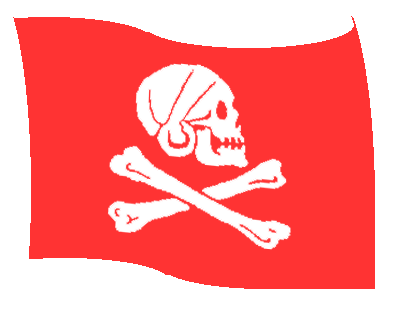Please be aware that the following post is the work of our esteemed member, Asherman, who kindly consented to assist me by writing sketches on pirates in whom he had taken a particular interest. I have provided illustrations with his consent.[/i]
Henry Avery (b. 1665?) AKA Henry Every, "Long Ben"[/size]


After serving as a Midshipman aboard a privateer, Avery joined the
Charles (45 guns) that was intended as the flagship for a small fleet charged with suppressing piracy in the Caribbean. After many delays the
Charles ended up alone in West Indies harbor. The crew was dissatisfied by their Captain's inactivity, failure to take prizes and drunkenness. Avery led a mutiny on May 7, 1694. The
Charles was renamed the
Fancy, and sailed away to a career of piracy. Avery had set his sights on one of the great prizes of the time; the Great Mogul's pilgrim fleet that sailed between India and the entry port (Mocha) to Mecca at the head of the Red Sea.
In route, they took three English ships near the Cape Verde Islands. Sailors from the captured ships joined Avery, and the captured ships were destroyed. Reprovisioned, Avery sailed on to the West Coast of Africa. Flying the English flag, Avery posed as a legitimate trader. When the natives came out to the
Fancy in their boats, Avery locked them up, stole their gold and later sold them into slavery.

Two small Danish ships were taken off Principe, and a number of the Danish sailors joined the crew. One of the ships was burned and the other converted to a second pirate ship. Trying to coordinate the two ships and control the crew on the consort proved too much trouble. Avery burned the smaller ship and added the crew to the
Fancy. This gave him a crew over 150 men, and it was crowded as the
Fancy sailed around the Cape of Good Hope and up to Madagascar.
Avery reprovisioned his ship, and may have careened her to clean the bottom. While getting ready to attack the pilgrim fleet, Avery was joined by other pirates also drawn to the prize of prizes. Those ships were:
Portsmouth Adventure (Capt. Joseph Faro) and the
Pearl (Capt. William Maze) from Rhode Island,
Dolphin (Capt. Want, Philadelphia),
Amity (Capt. Tew, New York), and Capt. Wake on
Susannah from Boston. Each of the American ships had a crew of about 60, so the pirate fleet had a total of around 550 men on six ships to attack the pilgrim fleet. Some reports put the number of pirates at close to 700, but we can't be sure since they weren't sticklers for keeping accurate records.

Together the pirate fleet sailed north and, off Cape St. John, encountered the
Fath Mahmamadi. Being a small ship it was taken without incident. The
Fath Mahmamadi carried between 50,000 and 60,000 pounds of treasure, mostly gold and silver. A few days later Avery found and attacked the
Ganj-i-Sawai. This was the Grand Mogul's largest ship carrying 40 guns, and a large well-armed crew under Capt. Muhammad Ibrahim who had a reputation as a savvy sailor and fierce fighter. In the first exchange of broadsides a lucky shot toppled the
Gaji-i-Sawai's main mast. Even worst, one of the
Gaji-i-Sawai's cannon exploded killing and wounding many of her crew. After two hours fighting the pirates were ready to board, and Capt. Ibrahim sent Turkish slave girls to augment his crew. It was a futile gesture and the
Gaji-i-Sawai fell into Avery's hands. It is rumored that Capt. Ibrahim hid out below to escape danger, but that doesn't seem in character with his reputation. Another rumor has it that the Grand Mogul's daughter was one of the pilgrims on the ship, and that she ran away with Avery and married him.
I was unable to find an estimate of the treasure carried aboard the
Ganji-i-Sawai, but it must have been many times greater than that on the Fath Mahamamadi. Each of the pirate's shares was said to be at least 1000 pounds, that suggests a total of nearly a million pounds and perhaps the richest single treasure taken at sea. Avery left the American ships behind and sailed back to the West Indies. There each of the pirates had to pay off the local governor for protection. Avery is said to have presented Governor Nicholas Trott a pair of ivory tusks worth a thousand pounds each, and the
Fancy.
Avery then disappears from history. It is widely thought that he returned to England under an assumed name and lived out his years enjoying his immense wealth. There are also stories that he was swindled out of much of the loot and died in extreme poverty. Some members of Avery's crew drew attention to themselves by their spending, drunkenness and loose talk. They were taken, and at least six were hung by the Admiralty. Though pirates like Blackbeard and Captain Kidd are still the stuff of legend, most of the world has forgotten Long Ben Avery. During the late 17th and 18th centuries Avery's 18 months of piracy was well known, and he was certainly one of the most successful pirates of all time.